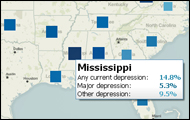
An estimated nine percent of all American adults currently suffer from depression, according to a new study published in the Centers for Disease Control's latest Morbidity and Mortality Weekly Report.
But a state-by-state analysis shows a wide range in depression rates between states, from 14.8 percent of those surveyed in Mississippi to 4.8 in North Dakota. And a number of demographic disparities are seen in how gender, age, health insurance coverage and employment status can play a part.
Using data from the Patient Health Questionnaire 8 that was part of the 2006 and 2008 Behavioral Risk Factor Surveillance System survey, current depression was defined as those adults who met the BRFSS conditions for "major depression" or "other depression." Respondents had major depression if for more than seven days in the past two weeks they had met five of eight set criteria for depression including at least one of the following: "little interest or pleasure in doing things" or "feeling down, depressed, or hopeless." They were considered as "other depression" if they met met two to four of the full criteria including at least one of the ones listed above. The full list of criteria appears at the end of this post.
Highest and Lowest Rates
Southeast states had the highest rate of currently depressed adults, with Mississippi leading the way at 14.8 percent. West Virginia, Alabama, Oklahoma and Arkansas also had significantly higher rates than the other states that participated. The colder states fared better on happiness, with North Dakota at the top of the list of least depressed states at 4.8 percent, followed by Minnesota, Alaska, Iowa and Colorado. Not all states participated in both years of the survey, and five states did not participate at all.
Use the interactive map below to view statewide current depression rates across the nation:
Disparities Among Demographics
Age and gender mattered when it came to who was more depressed. Those 18 to 24 and 45 to 64 had the highest rates of depression, both in the 10 percent range, as did women by about two more percentage points than men. The race/ethnicity with the highest rate was Black non-Hispanics, followed by Hispanics. White non-Hispanics had the lowest rate at almost five percentage points lower than Black non-Hispanics.
Education also seemed to play a role. The more education a person had the less likely they were to be depressed. Of those with less than a high school diploma, 17.1 percent were found to be depressed. That's 11 percentage points higher than those with at least some college.
And as to whether marriage makes you happier -- it apparently does, as long as you stay married. Married adults had a 6.5 percent rate of depression while those that were previously married had a 14.5 percent rate and those never married, 11.6.
Whether a participant was employed and had health insurance also played a part. Those with a job had a 6.4 percent rate of depression, while the unemployed had a rate three times higher at 21.3. People who were unable to work had the highest rate at 39.1. Retired participants had the lowest rate at 6.3 percent. And the participants with health insurance had about half the rate of depression as those without, researchers said.
How Health Plays a Role
The report does not provide statistics on health status and depression rates, but does highlight their close relationship. "Depressive disorders are more common among persons with chronic conditions (e.g., obesity, cardiovascular disease, diabetes, asthma, arthritis, and cancer); and among those with unhealthy behaviors (e.g., smoking, physical inactrivity, and binge drinking)." Some states with the least healthy behaviors, such as smoking, and highest rates of a poor self-reported health status also have the highest rates of depression, according to BRFSS data.
Criteria Used in the Study to Determine Depression
The eight criteria for depression (which were taken from the Diagnostic and Statistical Manual of Mental Disorders, Fourth Edition) iare listed below. A ninth criteria on suicide or possibility of self-injury was eliminated because "interviewers would not able to provide adequate intervention by telephone."
1) "Little interest or pleasure in doing things.
2) "Feeling down, depressed, or hopeless."
3) "Trouble falling asleep or staying asleep or sleeping too much,"
4) "Feeling tired or having little energy,"
5) "Poor appetite or overeating,"
6) "Feeling bad about yourself or that you were a failure or let yourself or your family down,"
7) "Trouble concentrating on things, such as reading the newspaper or watching television," and
8) "Moving or speaking so slowly that other people could have noticed . . . or the opposite: being so fidgety or restless that you were moving around a lot more than usual."
Source: CDC's MMWR: Current Depression Among Adults - United States 2006 and 2008
Suzette Lohmeyer is a staff writer for State of the USA.
Data visualization by Anthony Calabrese of State of the USA.
(Image: iStockphoto)
 Print This
Print This RSS Feed
RSS Feed